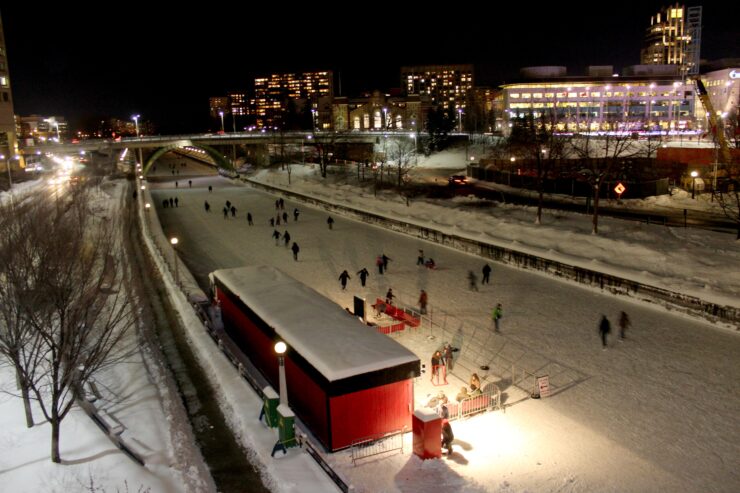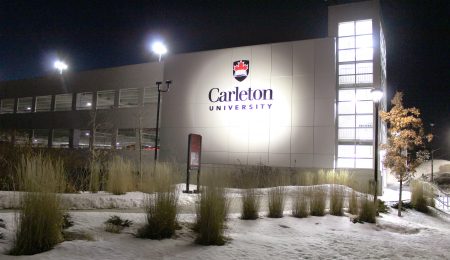Running through downtown Ottawa like a vein, the Rideau Canal (also known as the Rideau River) is both the literal and legitimate heart of the city.
The canal starts all the way back at Upper Rideau Lake, about 100 kilometres southwest of Ottawa, and snakes through a number of towns in rural Ontario, including Smiths Falls, Merrickville and Manotick, before reaching the city.
The portion of the canal most Ottawans are familiar with begins at Mooney’s Bay, where the river splits into two: One portion travels by Billings Bridge and Old Ottawa East before flowing between Sandy Hill and Vanier, emptying into the Ottawa River at Rideau Falls. The other will eventually become the Rideau Canal Skateway. The skateway begins at the Hartwell Locks at Carleton University and travels past Dow’s Lake, Lansdowne Park and under the Laurier and Mackenzie King Bridges before ending at the Ottawa Locks between Parliament Hill and the Chȃteau Laurier, emptying into the Ottawa River.
The massive skateway doesn’t go unnoticed: It’s officially recognized as the world’s largest naturally frozen ice rink, measuring in at 7.8 kilometres in length, equivalent to about 90 Olympic ice rinks. It was also designated as a UNESCO World Heritage Site in 2007.
The Fulcrum sat down with Bruce Devine, senior manager of facilities and management on the Rideau Canal Skateway, to get a quick lesson in how the world’s largest skating rink is built and maintained each year.
The Fulcrum: Bruce, can you tell us about yourself and the National Capital Commission (NCC)?
Bruce Devine: I’m a senior manager for the NCC. I’m part of the installation and program section, so I manage the Rideau Canal Skateway. I manage a team of four people and we oversee the strategies, objectives, staff and budgets for the skateway.
F: Can you walk us through the process of how the skateway is constructed each year?
D: It’s a long process. People don’t realize it but we have one staff person who works all year round on the canal. The season starts in the fall once Parks Canada lowers the water of the canal. We then install the large assets, such as chalets, restrooms, staircases, vehicle ramps and so forth. We deploy the electricity cables and then the water rises up to the skating level and we wait for it to freeze. Once it starts to freeze to a certain thickness, the ice-making crew gets on it with precaution and the proper equipment and they start to build the ice itself.
It’s a little bit dangerous when they do this, but they know their business and they’re very careful and have good security measures in place to prevent any accidents. It takes a while, it depends on the weather, to build the ice thickness up to 30 centimetres or 12 inches. Once that is done we deploy all the other small assets, the benches, the signage, the Christmas trees, the food concessions and what not. Once this is all done, that takes several days, we’ll open up the season to the public.
F: So once the skateway’s open, what comes next?
D: Then it’s a matter of regular maintenance, depending on what Mother Nature offers us. If it’s extremely cold, the different operations go from sweeping, flooding the ice, or using the pickup trucks with the plows to plow it, or a mix of everything, depending if it’s raining, snowing, or a mix of both or what not. The small equipment on a daily basis is removed and the ice crew does its task and we put everything back in the morning for 8 a.m. This is ongoing, and we monitor the ice quality regularly, especially when there’s mild weather for several days, checking the quality of the ice, the thickness, the density and so forth.
During the season we’re careful with the way we manage our waste. We compost, we recycle, and there’s the regular waste, and there’s a team at the warehouse that strips every bag of garbage and puts aside what’s compostable and what’s recyclable. At the end of the year, I forget the numbers, but tremendous results with respect to waste management. In the spring, once the season is closed, at some point we ask Parks Canada to lower the level of the water, allowing the ice to crack, and this helps it melt faster. Once it’s all melted we remove all of our equipment, do a second sweep of the bottom of the canal and we take off anything that floats that had frozen into the ice during the season. Then sometime in May Parks Canada puts the water level back to the summer level for the boats to circulate.
F: Do you ever find anything weird at the bottom when you do this sweep?
D: Sometimes we find funny garbage, sometimes we find bicycles, but not necessarily. In the summer this is the Rideau Canal, so all our equipment is at our storehouse and we repair the benches, staircase and so forth, so it’s a 12-month exercise.
F: How have you dealt with a shorter number of skating days in recent years? Are you looking into how climate change might impact the canal? (In 2016 there were just 18 skating days, the shortest season on record)
D: If you look at the average over the last five years, the average season the canal is open is 45 days, with about 30, 35 days of skating. There are some bad years, two or three years ago we only had 18 skating days. That was a record but an odd year.
There are some measures we have put in place. The way we build the ice, we build it faster. For the water surface that drains into the canal, there’s a way we capture this melting surface water and redirect it with pipes into the canal, so it prevents it from damaging the ice from underneath. The way we do our evening operations, that helps as well. We will, and the details aren’t known yet, but we will embark on a study on the possible impact of climate change, looking 30 years ahead. There’s some data that does exist, so we’ll have some people analyze that and once we understand what’s ahead of us we’re going to look at the types of mitigation measures we could put in place for different scenarios. The details of this work and analysis aren’t known yet but it’s our intention to proceed next year with that.
F: What do you think the canal symbolizes?
D: It’s definitely an icon for the nation’s capital and it’s well known throughout the world. I personally do receive some calls from Russia, Washington, various municipalities surrounding Toronto, Montreal, Germany, as to what our operations look like, how do we build our ice? I come across many tourists when I skate, from Yugoslavia, Germany, China, and so forth, so it is nationally well-known. We’re one of the top winter attractions in the city. It’s unique to our country, we’re surrounded by capital institutions: Parliament Hill is close by, universities, the National Art Centre, and so forth.
F: Is there a sense of community among your team, along with the staff on the canal?
D: I have a permanent team of four people and they’re all extremely passionate about the skateway: They love it, if they could sleep in the canal, they would. All the rest, there are about 200 people working on the canal but it’s all contracted out through private companies. We observe from talking to the workers themselves that there’s a sense of pride to be on this unique attraction. They all know what they contribute. At the beginning of each year, we assemble everybody to go over the previous year, I take the time to go over previous objectives. Also, all the comments we receive, through social media people are very generous. Every positive comment we receive we pass on to the workers to support what we tell them. It’s hard with the snow and it’s very cold at times, but at least they have an immediate impact. Some people telling me the regulars that skate the canal at their leisure just put their thumbs up to tell the staff how much they appreciate the quality of the ice. All these small gestures contribute to this sense of family. We’re all working towards the same objective: To create a positive experience for all users.
F: Do you have any interesting stories from your time on the job?
D: We received some comments about people making the big announcement to their partner on the canal, or others coming back for memories, so those are the types of memories we have.
F: Is there anything else you want to share or add for our readers?
D: For those who don’t have skates or don’t know how to skate, they can rent them, and the proper learning equipment you can rent too. Elbows, knee protectors, helmets, or a stand of some sort to help keep your balance.
Also, It’s important to be aware that the skateway is made of ice that floats, it’s on a stream, so the ice does crack and move. It’s natural that there are some cracks here and there, but people should pay attention to where they skate.
— With files from Amy Yee.





